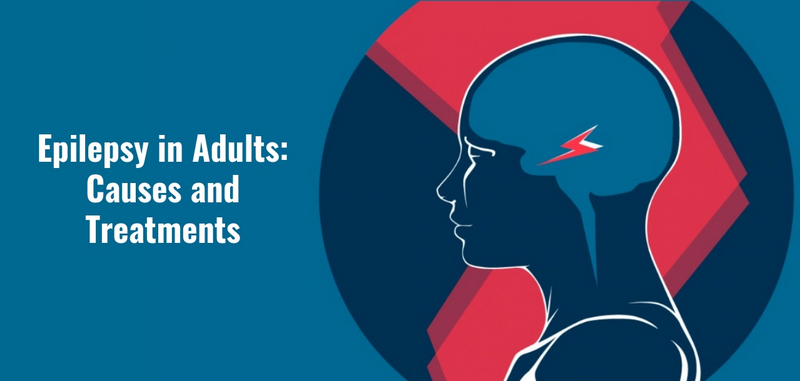
Epilepsy is a chronic disease associated with impaired activity of the cells of the cerebral cortex. Normally, nerve cells (neurons) transmit signals using small electrical impulses. During epilepsy, the normal processes of regulating the power of electrical impulses and the processes of their transfer between neurons are disrupted. As a result, a very strong electrical discharge occurs in the cerebral cortex, which can be conventionally compared with a short circuit. Sometimes this closure is limited to a specific area of the brain, in which case the seizure does not capture the whole body. If the pulse spreads over the entire surface of the cerebral cortex, the seizure is called generalized.
Causes of the disease
Epilepsy is a disease with many causative factors. In some cases, they can be established with a certain degree of reliability, sometimes it is impossible. It’s more competent to talk about the presence of risk factors for the development of the disease, and not about the immediate causes. For example, epilepsy can develop as a result of a traumatic brain injury, but this is not necessary. Brain injury may not leave behind the consequences in the form of epileptic attacks.
Other risk factors:
- genetic predisposition;
- acquired predisposition.
Hereditary predisposition lies in a special functional state of neurons, in their tendency to excite and generate an electrical impulse. This feature is encoded in the genes and passed down from generation to generation. Under certain conditions (the action of other risk factors), this predisposition is transformed into epilepsy.
Acquired predisposition is a result of previously transferred diseases or pathological conditions of the brain. The diseases that can cause epilepsy include:
- traumatic brain injury;
- meningitis;
- acute disorders of cerebral circulation (especially hemorrhage);
- brain tumors;
- toxic brain damage as a result of drug or alcohol use;
- cysts, adhesions, brain aneurysms;
- encephalitis.
Each of these risk factors as a result of complex biochemical and metabolic processes leads to the appearance of a group of neurons in the brain that have a low excitation threshold. A group of such neurons forms an epileptic focus. A nerve impulse is generated in the focus, which spreads to the surrounding cells, and excitement captures more and more new neurons. Clinically, this moment represents some kind of seizure. Depending on the functions of the neurons of the epileptic focus, this may be a motor, sensory, vegetative, mental, and other phenomena. As the disease progresses, the number of epileptic foci increases, stable connections between “excited” neurons are formed, new brain structures are involved in the process. This is accompanied by a new type of seizures.
In some types of epilepsy, initially a low threshold of excitation exists in a large number of neurons of the cerebral cortex (this is especially characteristic of epilepsy with a hereditary predisposition), i.e. the resulting electrical impulse immediately has a diffuse character. In fact, there is no epileptic focus. The excessive electrical activity of diffuse cells leads to the “capture” of the entire cerebral cortex in the pathological process. And this, in turn, leads to a generalized epileptic seizure.
Treatment of epilepsy
Treatment of epilepsy is a rather difficult task and most often lasts a lifetime. Much depends on the quality of the selection of drugs – from the frequency of attacks to a person’s ability to socially adapt. Epilepsy is usually treated on an outpatient basis.
Therapy has several goals:
- stop the emergence of new attacks;
- improve the prognosis for life and social adaptation;
- improve the quality of life of the patient;
- when remission is reached, stop taking the drugs without allowing the resumption of seizures.
According to various data, up to 70% of patients taking an adequately selected treatment completely get rid of the attacks. However, in order to choose the right drugs, the doctor must examine the patient in detail, assigning him a maximum of examinations. In addition, it is necessary to convey to the patient and his family members the importance of strict adherence to all recommendations, explain what to expect from treatment and what side effects may emerge.
The doctor should not only prescribe anti-epileptic drugs but also identify those factors that cause attacks – flickering light, lack of sleep, elevated body temperature, physical and mental exhaustion. Without the elimination of provoking factors, drug treatment is often ineffective.
To treat epilepsy, doctors prescribe special anticonvulsant drugs:
- Depakote (divalproex sodium);
- Gabapentin (neurontin);
- Tegretol (carbamazepine);
- Dilantin (phenytoin);
- Luminal (phenobarbital);
- Klonopin (clonazepam);
- Lamictal (lamotrigine);
- Keppra (levetiracetam);
- Trileptal (oxcarbazepine);
- Lyrica (pregabalin);
- Topamax (topiramate);
- Mysoline (primidone);
- Zarontin (ethosuximide);
- Valparin (valproic acid).
Treatment begins with minimum doses of the drug with a gradual increase. If necessary, medications can be changed. Also, sometimes it’s recommended to use a complex of anti-epileptic drugs (in cases where monotherapy with a single drug is ineffective).
Patients with epilepsy are hospitalized only in a few cases:
- at the first convulsive fit for examination;
- with the development of epileptic status;
- for the surgical treatment of the disease.
Patients are subjected to the surgical treatment of epilepsy in order to reduce the severity of the disease. Before surgery, the patient is carefully examined to identify a focus of excitation in focal or generalized epilepsy.
